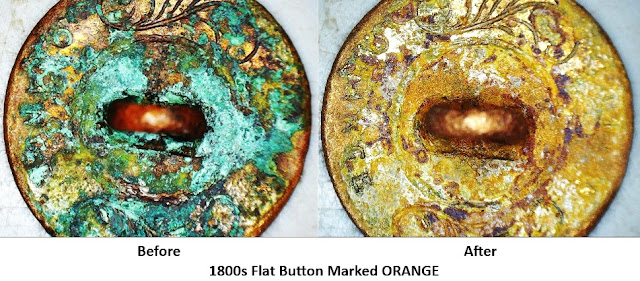Written by the Treasureguide for the exclusive use of the Treasure Beaches Report.
 |
| Flat Button Needing Cleaning. |
I came across an old brass flat button that needed some cleaning. So I decided to put it in white vinegar over night. The front of the button was not bad, but the back had a hard green crust, as you can see below.
After cleaning, I could see the word ORANGE on the left side of the button as shown above, and some remaining gilt.
All I did was let it soak in undiluted white vinegar over night (approximately 8 - 10 hours).
 |
| Old Milkglass Cosmetics Jar Used for Cleaning The Brass Button (also shown). |
Each metal detecting site varies in a number of ways. Beach or not, it takes time to get to know each site. Since beaches can be especially complex. It can take twenty or more visits before you really get to know some beaches. You can visit a beach for a long time before it gives up another of its many secrets. There are beaches that I visited that many times before learning that it held a type of treasure that I never suspected. After visiting one beach numerous times, it finally showed that it was hiding numerous fossils. On another occasion, it suddenly gave up one of the many16th century wreck coins it had been hiding. And that was after many visits of producing other nice treasures.
Beaches vary on numerous dimensions. The normal three dimensions is just the start of it. I'm talking now about the distribution of treasure. Certain spots tend to be better than others and those areas can be large or small, towards the front or back of the beach or, talking of layers, high or low on the beach.
Then there is the time factor, which by itself is complex. The changes that occur over time can be long term or short term. One of my favorite treasure beaches produced old items fairly frequently for years, but in recent years has been accumulating sand and has produced very little. But there are also the changes that occur from storms or tidal cycles. The long term and short-term changes can interact. Of course, one of the best situations would be a favorable long term trend followed by a storm and some good tides. On the other hand, a storm or good tides may not be enough to overcome a long-term negative trend of accumulation.
Detecting sites will also vary in the number of old finds they hold, as well as the accumulation or replenishment rate, which depends upon daily activity levels as well as special events.
The type and quality of treasure varies from site to site too. Some sites produce mostly cheap stuff, while others produce more valuable stuff.
The quality of value of a sites treasure is a subjective judgment to some extent. Sometimes detectorists just like one kind of treasure over others even if it is not as valuable.
It takes time to get to know a site. You might misjudge a site at first. You might give up on a site before discovering its secrets.
People tend to do the same things. One of the most common is to detect the same part of the beach. You can be attracted to one part of the beach and neglect another that has its own secrets. I can think of a couple beaches that before I got to know them better, I routinely spent most of my time in the wrong spots. I later learned that going a little farther north or south really paid off.
Despite the temptation to stick to the spots that have produced in the past, it can be a good idea to stretch your boundaries and explore. Check a little farther high, low, north, south and even once in a while check a totally new beach or recheck some beaches that never showed you much in the past.
It is a fine line. You don't want to leave good spots too soon, but there may be another spot nearby that is your pot of gold.
There is a lot to choose from. If you have narrowed down your hunting to just a few spots that aren't giving up much of anything, instead of giving up until a big storm or something comes along, consider using the time to explore some new areas. Don't do what the 80 percent are doing if you want better results. And don't get stuck in your own rut.
Of course you can't detect everywhere, but you don't need to. Do your research, either library or field research, use your head, and do some systematic sampling.
The first few or maybe several times you detect a site you are just getting an introduction. The next time you visit the site you might start with some ideas (hypotheses) but be sure to remain open to new observations and ideas. You are just starting to get to know the site.
There are times to explore and times to mine the heck of a spot. With beach detecting it is a very dynamic situation. Knowing more beaches and how they might change to both long and short term events will give you many options and opportunities.
I will say it once again: there is always some place to detect and something to find.
---
I highly recommend the book, Who Moved My Cheese, a best-selling busines book on dealing with change. It is a quick and easy read.
---
 |
| Source: nhc.noaa.gov. |
So we have an area that presently has a 20% chance of becoming a cyclone.
 |
| Surf Forecast for the Fort Pierce Area from SurfGuru.com |
A little rougher surf is forecast for the Treasure Coast but nothing that will affect the beaches much.
Good hunting,
TreasureGuide@comcast.net

